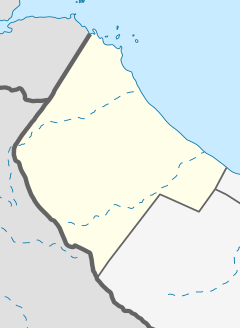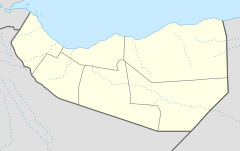Masjid al-Qiblatayn, Zeila
| Mosque of the Two Qiblas | |
|---|---|
 | |
| Religion | |
| Affiliation | Islam |
| Region | Horn of Africa |
| Location | |
| Location | Zeila, Awdal, Somaliland. |
| Geographic coordinates | 11°21′14″N 43°28′26″E / 11.35389°N 43.47389°E |
| Architecture | |
| Type | mosque |
| Minaret(s) | 1 |
Masjid al-Qiblatayn (Somali: Masjidka Labada Qibla, lit. 'Mosque of the two Qiblas'; Arabic: مَـسْـجِـد الْـقِـبْـلَـتَـيْـن) is a mosque in Zeila, situated in the western Awdal region of Somaliland. The name of the mosque reflects the belief that it was once aligned to both Mecca and Jerusalem.[1][2]
Date
[edit]The oldest remains on site are undated[3] and further archeological investigation is needed to understand them.[4] According to local tradition, Muhammad's family migrated to Abyssinia in the early seventh century and constructed the mosque thereafter.[5][4][6][7]
At present, scholarly dates for the Islamicization of the region are uncertain and may be as late as the thirteenth and fourteenth centuries, though others suggest a possibly earlier but unknown date.[8][9]
Description
[edit]The mosque's name means 'mosque of the two qiblahs', referring to its two mihrabs. According to tradition, one of the mihrabs was oriented north toward Mecca and the other northwest toward Jerusalem.[4][10]
The building is largely in ruins. This is due to repeated diggings as well as exposure of the foundations of the structure, without any conservation efforts protecting the site. In 2007, George Abungu produced a report of the site as part of a UNESCO assessment mission.[10]
Only one mihrab, oriented northward, was visible. The remains of another structure nearby are visible, possibly indicating that the mosque underwent two different phases of construction. It also contains the tomb of a sheikh named Babu Dena.[4]
See also
[edit]References
[edit]- ^ Falola, Toyin; Salau, Mohammed Bashir (2021-12-06). Africa in Global History: A Handbook. Walter de Gruyter GmbH & Co KG. p. 45. ISBN 978-3-11-067801-7.
- ^ Ylönen, Aleksi (2024-01-25). The Horn Engaging the Gulf: Economic Diplomacy and Statecraft in Regional Relations. Bloomsbury Academic. p. 112. ISBN 978-0-7556-3515-3.
- ^ Insoll, Timothy (2020). "Ethiopia and the Horn of Africa". In Walker, Bethany; Insoll, Timothy; Fenwick, Corisande (eds.). The Oxford Handbook of Islamic Archaeology. Oxford University Press. p. 430. ISBN 978-0-19-998788-7.
- ^ a b c d Fauvelle-Aymar, François-Xavier; Hirsch, Bertrand; Bernard, Régis; Champagne, Frédéric (2011). "Le port de Zeyla et son arrière-pays au Moyen Âge: Investigations archéologiques et retour aux sources écrites". In Fauvelle-Aymar, François-Xavier; Hirsch, Bertrand (eds.). Espaces musulmans de la Corne de l'Afrique au Moyen Âge (in French). Addis Ababa: Centre français des études éthiopiennes. pp. 27–74. ISBN 9782821882652.
- ^ Mire, Sada (2015-03-01). "Mapping the Archaeology of Somaliland: Religion, Art, Script, Time, Urbanism, Trade and Empire". African Archaeological Review. 32 (1): 129–130. doi:10.1007/s10437-015-9184-9. ISSN 1572-9842.
- ^ Briggs, Phillip (2012). Somaliland: With Addis Ababa & Eastern Ethiopia. Bradt Travel Guides. p. 7. ISBN 978-1841623719.
- ^ The Muslim World. Motamar al-Alam al-Islami; World Muslim Congress. 1964. p. 7.
- ^ Insoll, Timothy (2017). Peacock, A. C. S. (ed.). Islamisation: comparative perspectives from history. Edinburgh: Edinburgh University Press. pp. 248–249. ISBN 978-1-4744-1712-9. OCLC 959035754.
- ^ Simpson, Edward; Kresse, Kai (2008). Struggling with History: Islam and Cosmopolitanism in the Western Indian Ocean. Columbia University Press. p. 62. ISBN 978-0-231-70023-8.
- ^ a b Insoll, Timothy (2020). "Ethiopia and the Horn of Africa". In Walker, Bethany J.; Fenwick, Corisande; Insoll, Timothy (eds.). The Oxford handbook of Islamic archaeology. New York, NY: Oxford University Press. p. 437. ISBN 978-0-19-750787-2.


 French
French Deutsch
Deutsch
